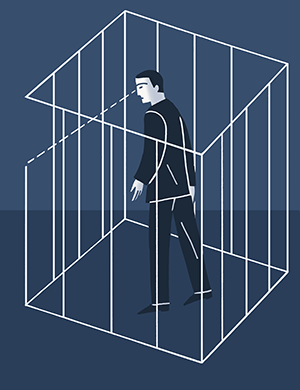This fall he spoke with Amherst’s Lisa Raskin, the John William Ward Professor of Psychology (Neuroscience), about the hypothesis he presents in his new book.
RASKIN: Your new book pulls together literature, neuroscience, psychology and philosophy to understand the theory of capture. Can you start by explaining the concept?
KESSLER: The hypothesis is that a common mechanism underlies many of our emotional struggles and mental illnesses. Simply put, a stimulus—a place, a thought, a memory, an object, a person—seizes our attention and there’s a shift in our perception. I may sense that shift, but I don’t necessarily understand where it comes from when it happens. The experience occurs outside our conscious control, and we surrender to it before we perceive that it’s going on.
You hear, “I can’t resist sugar,” or “I can’t resist nicotine.”
My hand reaches for that chocolate chip cookie before I even think, Do I want that chocolate chip cookie? A drug, a food or a behavior can affect how I feel, and the next time I get exposed to that stimulus, I arouse that same neural circuitry and get caught in a cycle. I pick up that one cigarette and then 781,000 more for the rest of my life. Out of all the stimuli bombarding me, I can only focus on certain things; I’m going to pick out those that are important to me, based on past learning and past memory.
Clinicians in my field have said that between the stimulus and the response is freedom.
That’s key. There’s always a moment where the more rational, higher cortical circuits allow me to possibly change course. I’m stimulated. I feel a certain way. I’ve not yet acted. But certain stimuli become so strong, so powerful, that in certain instances, after repeated experiences, we probably sense very little opening for freedom.
Your book begins with David Foster Wallace ’85. What did you learn from talking with his parents, siblings and Amherst friends?
His depression started in late adolescence. I became interested in whether depression involves a continual focus on negative thoughts, experiences and memories to the exclusion of all else, and how someone who’s depressed gets captured by these thoughts and experiences and narrows his or her attention, focusing on only the most negative stimuli. In his writing, Wallace explained the feedback cycle: I focus on the negative, that makes me feel sad, and I end up focusing on what makes me feel sad.
A negative thought creates the emotion. When you live in that emotion, you think it’s real.
I’m broken, I’m a failure, I’m never going to feel better: The output of that cycle becomes the input, the next round. It’s self-sustaining. That chocolate chip cookie I can walk away from. Tobacco I can walk away from. But myself—I’m always there. So I focus internally, but I can also focus on external stimuli— you slighted me; you made me feel bad. And I can be captured by an abiding sense of rage.
So is it an addiction, almost, to your own feelings?
Look at psychopathic behavior. It has been viewed as lack of conscience, a failure of empathy. That focuses only on what’s absent in the mind of the psychopath. But take any mass shooter: Something made him enormously angry. I think there are neural circuits that underlie that response.
You write about the author William Styron. He decides to commit suicide, but after listening to the Brahms Alto Rhapsody, his feelings for his mother are so strong that he decides to save himself. He’s overwhelmed by sadness, and then he’s reminded of his mother and is instantly changed.
As bad as he felt about himself, something even more meaningful captured him. The most important secret about capture is that one of the most effective ways to be released from it is to find something else that is more meaningful—to replace a form of negative capture with a positive one.
I think about people who have generalized anxiety disorder. One symptom is that they’re anxious about being anxious. They worry about going outside because they worry they’ll become anxious. What would happen if they could lose themselves in something else?
Look at Alcoholics Anonymous. What gets substituted for alcohol—fellowship, sobriety? Something takes the place that’s more important. It’s easier said than done. At Amherst, David Foster Wallace was a student having bad thoughts, and those bad thoughts isolated him: I can’t share what’s going on in my head because people will think worse of me. If you can get to young people at an early stage and explain to them that they’re not bad, that we all get captured by certain things, can you at least alleviate the pain that accompanies the isolation?
Medicine can attenuate the bad feelings, but somebody with social phobia, for example, then has to learn how to live in the world. Studies show medication combined with therapy is most effective.
My sense is that antidepressants quiet the circuitry, and psychotherapy allows those who are suffering to change the context—to find something else that captures them, or at least to manage the negative thoughts.
If you can learn to turn down the noise, to quiet the thoughts, you can understand what you’re saying to yourself.
Being able to understand how our minds work—isn’t that a key part of a liberal arts education?

